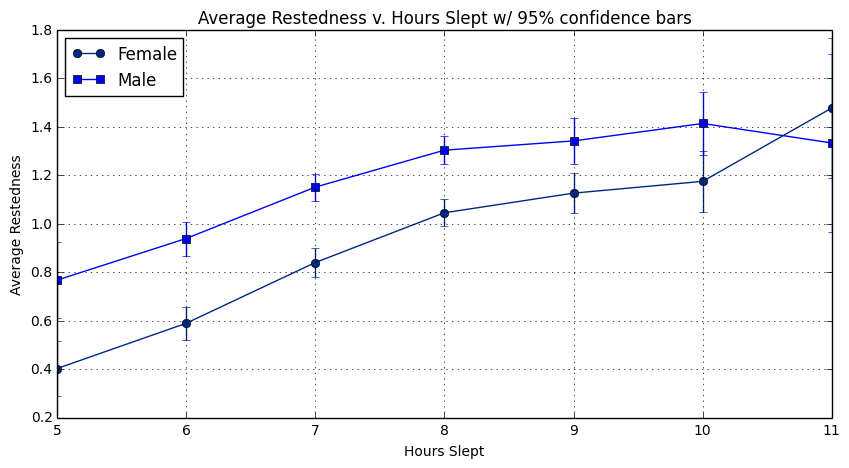-
Research shows that women and men sleep differently. Women take longer to go to sleep (sleep latency), spend about 20 minutes longer in bed and spend more time in deep sleep than men.
There is a growing body of evidence that men and women manifest sleep disorders differently. Broadly speaking, a third of American adults are not getting enough sleep on a regular basis. According to the National Institute of Neurologic Disorders and Stroke, about 40 million people in the United States suffer from chronic long-term sleep disorders each year and an additional 20 million people experience occasional sleep problems.
Research shows that women and men sleep differently. Women take longer to go to sleep (sleep latency), spend about 20 minutes longer in bed and spend more time in deep sleep than men. Further, while even the non-disordered population of women report poorer sleep, analysis of sleep studies are not able to find evidence of poorer sleep.
Why The Differences In Sleep for Men Vs. Women?
While sex chromosomes and hormonal differences in the sexes contribute to these differences in sleep at the cellular and organ level, a combination of cultural, environmental, and social issues also influence biological factors and ultimately the kind of sleep men and women each get each night.
Do Women Need More Sleep Than Men?
A widely quoted article published in the Daily Mail in January 2010 stated that women needed “20 minutes more shut-eye than the average man.” The article referenced Dr. Jim Horne, Britain’s leading expert in sleep.
In a more recent article, Professor Horne confirmed that he never said women actually need more sleep. Referring to his research published in 1996, he says that women tend to sleep for around 15 minutes longer than do men, which is more apparent in those younger than 45 years of age. He concluded with the comment “this is not because of myths relating to more delicate constitution, but may well be due to women having more deep or slow wave sleep and a sign of their having greater brain (cortical) recovery during sleep.”
Getting the right amount of sleep is defined as seven to eight hours per night — for both men and women. However individual needs may vary and some people may get by on less. Beyond the amount of sleep, equally vital is the quality of sleep we are getting each night.
A Rundown of Sleep Disturbances In Women and Why They Happen
Insomnia, the most common sleep disorder, affects more women than men and women are more likely to have daytime sleepiness.
There are a number of hormonal shifts that are unique to women that affect quality of sleep. Premenstrual symptoms such as bloating, breast tenderness, pain, and irritability may all disturb sleep. A majority of women report sleep disturbances during pregnancy, and during menopause more than 36% of women experience hot flashes.
From a cultural and social standpoint, women remain the primary caregivers for small children and aging parents, which may impact their sleep more than men.
Women suffer from nighttime pain such as migraines, tension headaches, and arthritis more frequently than men.
Restless leg syndrome (RLS), usually described as a strange itching, tingling, or crawling sensation deep within the legs, is a neurological movement disorder that affects 12 million people. Although women are at twice the risk for RLS as men, the sex differences appear to be a result of pregnancy. RLS also worsens with increasing with age and women appear to have more comorbid problems and are more likely to complain of sleep related symptoms as they age.
Obstructive sleep apnea (OSA) is a potentially dangerous sleep disorder that affects as many as 26% of adults 30-70 years of age. It causes breathing to repeatedly stop and start during sleep. Men are twice as likely as women to have sleep apnea but men are diagnosed with sleep apnea almost 8 times more often than women. The importance of OSA in women is increasingly being recognized along with a number of gender-related differences in symptoms, diagnosis, consequences, and treatment.
Women with OSA report un-refreshing sleep, fatigue, insomnia, and depression while men report snoring, snorting, gasping, and sleepiness. Women tend to have less severe OSA and while prevalence rates are lower in women, fewer women receive a proper evaluation and diagnosis. In other words, while women are half as likely as men to have OSA, they are eight times less likely to undergo a sleep study.
While men and women have varying propensities and symptoms for the various sleep disorders as stated above, the big takeaway is that women are likely under-diagnosed.
SleepWatch Data on: Women’s Vs. Men’s Sleep
SleepWatch surveyed its users and asked them if they had been diagnosed with specific disorders, including Sleep Apnea. Of the total respondents, 32.8% reported having sleep apnea. Of those users reporting having sleep apnea, 73.5% were male and 26.5% were female.

We also looked at a large sample analyzing user self-reported restedness. Below you will find two graphs. The first graph has SleepWatch’s own index of restedness on the Y-Axis, with total hours of sleep along the X-Axis, ranging from 5 hours of total sleep to 11 hours of total sleep. The second graph has SleepWatch’s index of restedness on the Y-Axis, with the hour of waking along the X-Axis, i.e. 4AM through 11AM.
How rested Women feel versus Men by number of hours slept.

How rested Women feel versus Men by Wakeup Time

Bottom Line (For Women and Men)
Sleep is the cornerstone of good health. The body requires at least seven to eight hours of quality sleep to repair and restore itself. Thirty-five percent of the population does not get adequate sleep and 40 million people have a sleep disorder. Women and men each have unique issues that require appropriate evaluation and treatment tailored to their unique needs.







